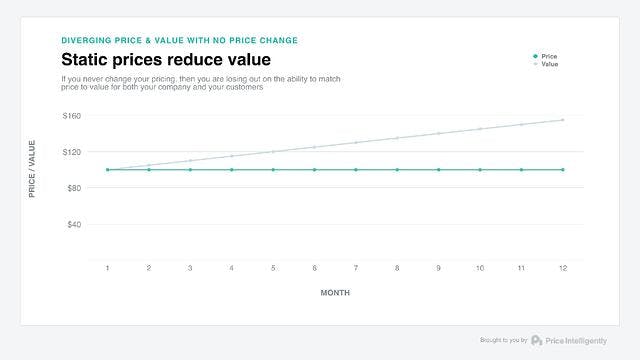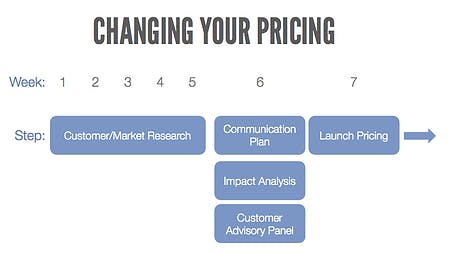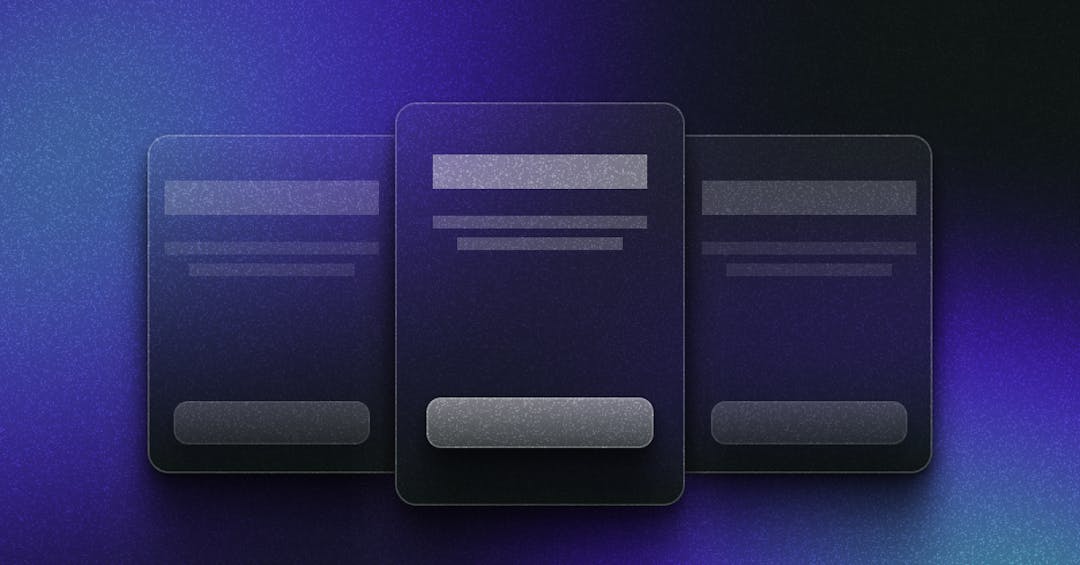Price increases are vital for growth, yet they are still avoided. Here's how to raise prices and customer satisfaction all at the same time.
Raising prices is the ultimate conflict for a SaaS company. On one hand, a price increase leads to more revenue and better unit economics. On the other hand, it can lead to angry current customers and potentially fewer future customers.
In the heads of founders, the latter nearly always carries the day—they err on the side of caution and keep the prices they “promised.”
This is understandable. Price increases are scary. People balk at the idea of asking for any money, let alone more. But raising prices is inevitable for a well-run company. Not understanding this, and not changing pricing is a fatal mistake.
Price raises are a sign of a well-functioning team and a growing product, showing that you are constantly reassessing and realigning the value you provide for your customer. But they are scary. Pricing strategy is in our blood, so here is how we coach our customers to talk about price increases with their customers to focus on value and show exactly what customers will get in return.
Why you have to raise prices
As you grow as a company, you grow in two ways:
- Your product grows. You add or remove features, but you should overall increase the value that your customers can get from using your product. This growth might come every six months as you release new features, or it could be daily if you have a policy of continuous integration.
- Your understanding grows. You get to know your market and get to know your customers. Every day comes with new insights into what matters to these people and what they truly value.
If your pricing is static during all of this growth, you are losing revenue. This is because the value of your product is increasing:

If you add five dollars of value for your customers each month but never change your pricing, then in one year you'll be underselling your product and your company by 60%. This might seem like a boon for your customers, but in the long run, a lack of price/value matching hurts them as well:
- Less to invest. Adding value month-on-month only works if the company can afford the growth. You can't if prices are set too low. Your product will stagnate if price doesn't match value.
- Lowered expectations. As your product becomes “cheap” for the value it offers, it starts to match those expectations. Your customer acquisition cost (CAC) will have to be lowered to balance lowered lifetime value (LTV), so newer low-value customers will be acquired. The product will then start to shift towards their needs and value and away from your initial customers. You'll lose those customers, but they'll also lose the ability to succeed with your product.
- Less understanding. Without price increases fueling your curiosity, you'll lose this window into understanding your customers. A price change, both pre and post, is a great opportunity to elicit feedback and find out more about your customers.
This is a constant cycle, so your prices have to be on a constant cycle as well. If you don't, you'll stagnate, lose revenue, lose growth, and lose your company.
Test your prices like you test your product
Here is a graph that won't surprise you:

Customers are way happier with lower price increases. Popes and bears come to mind.
This type of graph might be taken as evidence against price increases. It isn't. You can get pretty much perfect NPS scores and still increase your pricing. What this graph is actually evidence of is that you have to constantly be thinking about price increases. If you leave it too late and you suddenly realize you have to increase prices 100% to maintain your unit economics, customer satisfaction will take a hit.
But if you are iterating on your pricing and making smaller incremental changes, you can increase prices by 20-30% and still maintain high NPS scores. But if you are truly on top of pricing, even this will be a large change. By thinking about pricing in terms of testing and “sprints,” as you do product, you can make smaller changes that track your product and keep customers happy.
Just as you will research what new features or products to add, you need to research what new pricing will look like. And you need to think about this from the customer perspective, just as you do with your product. You need a five-step framework on a constant cycle to see whether you should have different pricing:
Step 1: Start with research, into both customers and market. This means revisiting your buyer personas and updating as needed:
- Feature value analysis—if you have recently released new features, are these making an impact on your customers? Any shift in your most/least valued features could mean that you need to make changes in pricing, or at least in the way you package your tiers.
- Price sensitivity—obviously important knowledge to have. You have to have a constant understanding of your customers' willingness to pay. If you are raising prices outside of these parameters, you will upset people and lose customers. By understanding the boundaries of your pricing, you can push them with confidence.
- Unit economics breakdown—you want price increases to improve unit economics. But unit economics involves more than just revenue. It incorporates the lifetime of the customer and acquisition costs, both of which can be impacted by price changes.
Step 2: Then you need to develop your new pricing andreview with select customers. If you've got a Slack channel set up for early adopters or your community, reach out to a few and ask them about the issues they would have with the new pricing
Step 3: In tandem, run an impact analysis for your current customers. While you are getting that qualitative feedback from customers, you'll also need a quantitative understanding of what will happen under the new pricing structure. By seeing how your current customers will be affected, this will give you a sanity check for the change, and also give you the chance to reach out to any that might be in line for the biggest increases.
Step 4: While you are working on those, hone your communication plan. You need to be transparent about your new pricing. Working out what you are going to say, to whom, and when is possibly the most critical part of rolling out price changes in terms of keeping satisfaction high.
Step 5: Finally, launch. And get feedback!

Communicate value, not price
If there is one concept that is foundational to pricing strategy, it is this. What matters is the value people will get in exchange for the price, not the price itself.
Sure, people will want to know the new pricing and structure. But the question they really want answered is, “What will I get in return?”
This is why communication is the important part of a price raise. Anyone can raise prices, but raising prices and customer satisfaction requires a strong understanding of your customers' valued features and willingness to pay, which you get from your research above. A strong communication plan that frames the price increase in these terms.
Get it wrong and customers will churn, acquisition will fall, and you'll lose money. Get it right, though, and customers will 100% understand that they are still getting great value with your product. The value is the important part. Yes, they will want to know the new pricing and you have to be upfront about that, but you have to be clear about the extra value that you are providing as well. Your communication plan needs three fundamental components to succeed:
1. It needs to be to the point.
Don't waffle on about your achievements so far. Get to the point, and that point is value. You should decide with your team the core value proposition that best aligns with your new pricing. This should then be front and center of your email to current customers, your blog post announcing the change, and in the brains of your customer success team when they start to be asked questions.
2. It needs to include specific plans for current customers.
Maybe you aren't increasing prices for current customers. In that case, price increases won't bother them too much. But if you are going to be changing up on your customers, then you need to decide how it will impact them. You have three options:
- If the increases are small, as they should be if you are constantly iterating and want to keep satisfaction high, then you can simply include them in the change. Some will churn, but if value = price, most will stay.
- If it's a big change, then you can grandfather them into their current rate. This means that their price is set to what was initially promised, no matter what increases you implement in the future. This can work for a handful of customers, but defeats the purpose if it goes beyond that.
- Your best bet for keeping customers and satisfaction high is a grandfather discount. This ties them into their current rate for a predetermined time period, say the next year. When the year is up, their pricing increases in line with all other customers. This is also a great way to tie customers into long-term, annual plans. Say that they can “lock in” their current price for the next year if they upgrade before the price increase goes into effect.
3. It needs to ask for feedback.
This is vital. Part of the reason for a price change is to align value and price for everyone. You will get feedback from your select customers during testing, but you'll get a better understanding from all your customers if you open up communication channels with them during price changes. This is one of the things founders hate about price changes, but it is the only way you get better.
Not everyone is going to get it. You will lose customers in the short term. But in the long-term, by showing customers the value they get for the price, the pricing can be anything as long as it truly represents that value.
It doesn't have to be scary
Price increases are scary only if you don't understand what pricing is—the exchange rate of value for your product. Once you understand that you are increasing value, you'll understand you can increase pricing iteratively. This makes sure you don't leave money on the table as you get better, and makes sure that your customers get a product that they are satisfied with.


